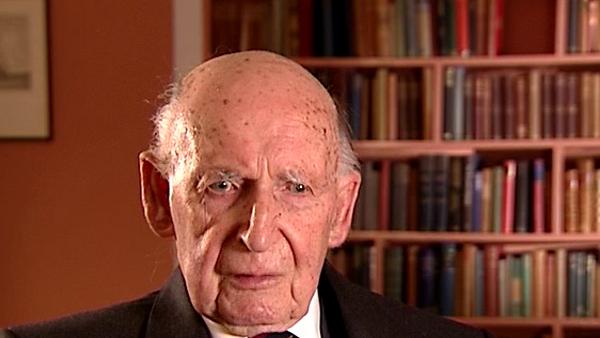NEXT STORY

Work on transient echoes and a letter from TL Eckersley
RELATED STORIES

NEXT STORY

Work on transient echoes and a letter from TL Eckersley
RELATED STORIES


|
Views | Duration | |
|---|---|---|---|
| 41. Release from the army and my desire to get back into research | 131 | 03:06 | |
| 42. My wife Joyce | 321 | 07:28 | |
| 43. My passion for music and especially the organ | 448 | 05:07 | |
| 44. My love of the countryside and trees | 177 | 06:23 | |
| 45. Returning to Manchester and work on cosmic ray showers | 117 | 07:11 | |
| 46. Looking for somewhere to work with no electrical interference | 132 | 03:16 | |
| 47. The first images on my cathode ray tube at Jodrell Bank | 157 | 04:42 | |
| 48. How Jodrell Bank began | 191 | 03:57 | |
| 49. Early days at Jodrell Bank and the Park Royal | 126 | 03:16 | |
| 50. Work on transient echoes and a letter from TL Eckersley | 121 | 05:23 |


We've reached the stage in the story of Jodrell Bank where, in 1945, I had borrowed this gun-laying four meter radar equipment from Hey, and the army had deposited me, in December 1945, in the grounds of the Botanical Department, and the old huts, they still exist there. I had... in the early part of 1946, I had with me JA Clegg, who had been in Telecommunications Research Establishment, but he was not a member of my group, but he had been... he had become an expert on aerials, and his aid, during the next few months, was vital to what happened subsequently. I also acquired another young from TRE, named Bandwell, and he was a New Zealander. I had nothing to do with him during the war, but he also came to work with me at Jodrell.
Now, we moved the... we got a load of stones, and built a track, which now leads into the powerhouse, and moved our radar system over to somewhere where the powerhouse now exists. And then we decided to get more spacious accommodation, and Clegg was sent to drive away what we called a Park Royal. Now, in those days, there was so much disposal of equipment going on that there was no problem in ringing up previous colleagues, and asking if they could give us some more radar equipment. So we sent Clegg away, to drive a very large vehicle, which we called the Park Royal. That was the official name of it. And we drove this system into the field, until it just became stuck in the mud, and we couldn't drive any further, and we moved our radar equipment into this Park Royal. It is somewhere, as far as location is concerned, it is close to where the Mark Two Telescope is now, and that building, the control building of that telescope, I don't know, but we called it for a long time, the Park Royal. Anyhow, this vehicle was close to that site. And it was there in 1946 that we carried out our first researches on the meteor phenomenon.
Bernard Lovell (1913-2012), British radio astronomer and founder of the Jodrell Bank Observatory, received an OBE in 1946 for his work on radar, and was knighted in 1961 for his contribution to the development of radio astronomy. He obtained a PhD in 1936 at the University of Bristol. His steerable radio telescope, which tracked Sputnik across the sky, is now named the Lovell telescope.
Title: Early days at Jodrell Bank and the Park Royal
Listeners: Megan Argo Alastair Gunn
Megan Argo is an astronomer at the University of Manchester's Jodrell Bank Observatory researching supernovae and star formation in nearby starburst galaxies. As well as research, she is involved with events in the Observatory's Visitor Centre explaining both astronomy and the history of the Observatory to the public.
Alastair Gunn is an astrophysicist at Jodrell Bank Observatory, University of Manchester. He is responsible for the coordination and execution of international radio astronomical observations at the institute and his professional research concerns the extended atmospheres of highly active binary stars. Alastair has a deep interest and knowledge of the history of radio astronomy in general and of Jodrell Bank in particular. He has written extensively about Jodrell Bank's history.
Tags: Jodrell Bank, British Army, Telecommunications Research Establishment, World War II, Park Royal, J A Clegg
Duration: 3 minutes, 16 seconds
Date story recorded: January 2007
Date story went live: 05 September 2008